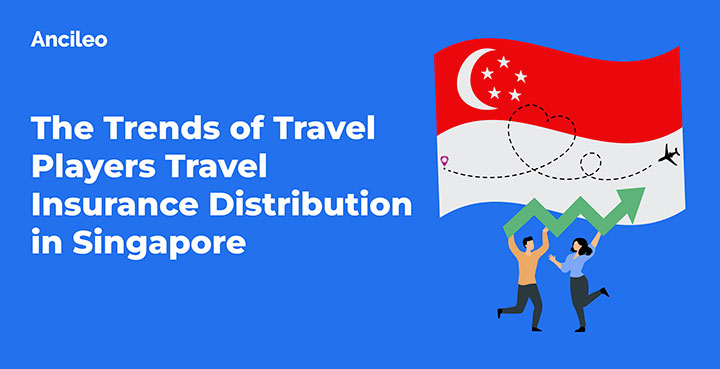
Travel insurance has become a staple for travelers who want to protect their trips and investments. With the growth of the travel industry, it’s no surprise that travel players have become a significant force in the distribution of travel insurance. From airlines to online travel agencies (OTAs), travel players offer an array of insurance products and services to travelers.
In this article, we’ll take a closer look into the increasing significance of travel players in travel insurance distribution, with a specific focus on the Singapore market. Our insights are based on an extensive research we recently conducted on the travel insurance needs and preferences of Singaporean travelers.
Our research shows that the majority of travelers are likely to purchase trip insurance through travel players. In fact, 23% of respondents stated that they are very likely to purchase travel insurance products through these channels. On the other hand, only 16% of travelers are not willing to purchase travel insurance via travel players.
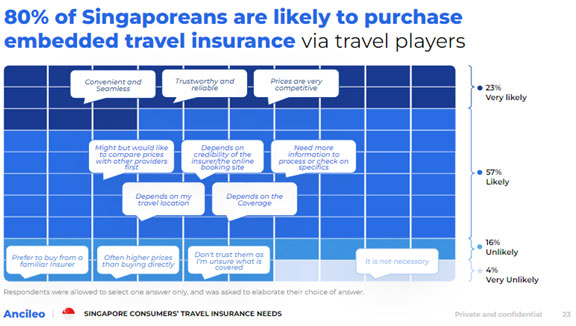
The likelihood of purchasing in-path travel insurance varies across generations. Generation X, Y, and Z (aged 19-56 years old) are more likely to purchase travel insurance through in-path channels, while Baby Boomers (aged 57 years and above) are the least likely to do so.
Moreover, our research suggests that travelers who are likely to purchase in-path travel insurance are planning to travel to countries in the APAC region. In terms of priorities, emergency and medical expenses coverage (including COVID-19) are their key priorities.
Travelers in general are keen on buying travel insurance products from trusted travel players, with the younger demographic exhibiting a distinct preference for purchasing them during their booking journey. These findings highlight the increasing significance of travel players as a distribution channel for travel insurance products.
DOWNLOAD THE REPORT TO GET MORE INSIGHTS
Travelers’ willingness to purchase travel insurance from travel players is influenced by several factors. Our research has identified the top factors that motivate travelers to purchase travel insurance from travel players.
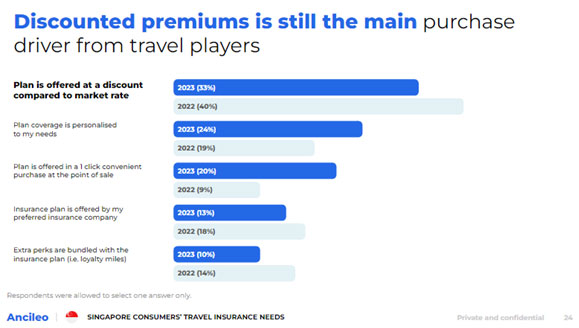
Travelers are more likely to purchase a travel insurance plan from travel players if it is offered at a discount compared to the market rate. This factor is particularly appealing to travelers who take short weekend trips, according to our study.
A personalized coverage plan is also a significant factor that influences travelers’ decision to purchase travel insurance from travel players. Generation X, aged between 42-56 years, is more likely to purchase travel insurance plans that are tailored to their individual needs.
Travelers also prefer the convenience of purchasing travel insurance plans with just one click at the point of sale. This feature is particularly attractive to younger generations, such as Generation Z.
Many travelers prefer to purchase travel insurance from their preferred insurance company, and if that company is offering a plan through a travel player, they are more likely to purchase it.
Extra perks bundled with the insurance plan, such as loyalty miles, can also influence a traveler’s decision to purchase a travel insurance plan from a travel player.
It is worth noting that most Baby Boomers, aged 57 years and above, are not motivated by any of these factors and prefer to buy directly from an insurance company.
Understanding the factors that motivate travelers to purchase travel insurance plans from travel players is essential for travel insurance companies to tailor their offerings and increase their market share in the travel insurance industry. By providing personalized plans, offering discounts, and bundling extra perks with the insurance plans, travel players can attract more customers and increase their revenue.
Based on our research, we found that travelers are increasingly open to purchasing non-travel insurance products from travel players. Generation X travelers (42-56 y/o) are particularly interested in Personal Accident Insurance and Critical Illness Insurance products, while Generation Y travelers (26-41 y/o) are more inclined towards Life Insurance products.
We found that family travelers are the most interested in investment-linked insurance products, such as endowment, savings, and retirement plans, as well as home insurance products. On the other hand, the majority of Baby Boomers (57+ y/o) are not interested in purchasing non-travel insurance products from travel players.
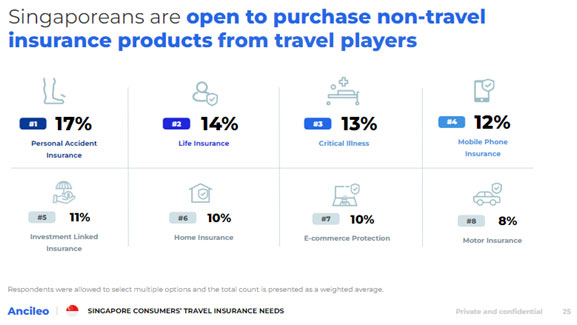
It is clear that there is a growing willingness among travelers to consider non-travel insurance products offered by travel players. This implies that travel players can capitalize on the opportunity to diversify their offerings and serve a broader spectrum of insurance needs. By understanding the preferences of different traveler demographics, travel players can develop targeted and personalized insurance products that meet the unique needs of their customers.
Airline companies are constantly seeking opportunities to enhance their revenue streams and increase customer loyalty. One strategy that has proven to be effective is partnering with global insurance companies to offer a range of insurance products beyond traditional travel insurance. This mutually beneficial collaboration allows airlines to offer added value to their customers, adding more fuel to their willingness to buy insurance products from them.
Here are some examples of Singaporean airlines that have made partnership with global insurers:
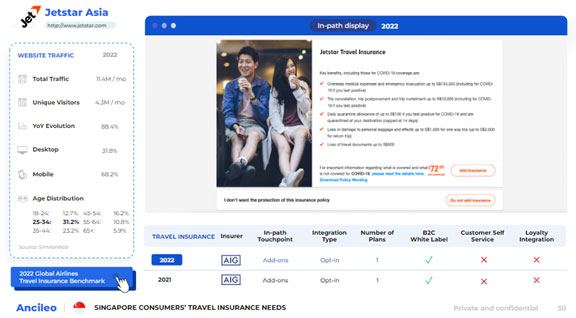

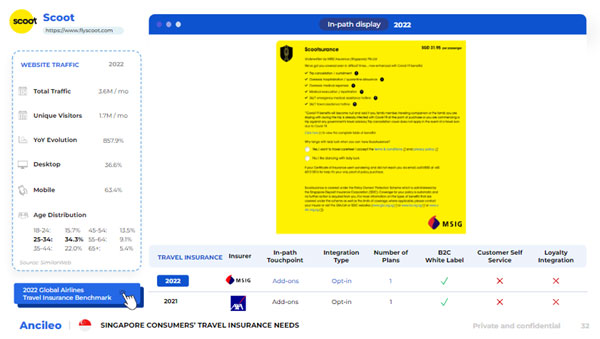
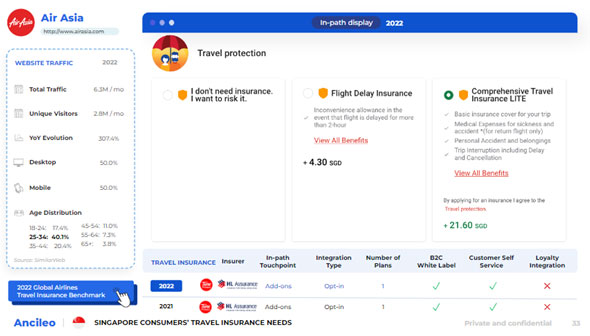
Airline companies are not just stopping with their core business of providing air travel—they have found success through utilizing the power of cross-selling. Here, let us dive into two case studies that showcase exemplary strategies for leveraging this strategy to gain more revenue.
The first case study is Cebu Pacific’s cross-selling strategy called “CEB Piso Protect”. This product is a personal accident insurance coverage for hospitalization and surgery due to accidents, with affordable premium payments starting from as low as 1 peso (US $0.02) a day. CEB Piso Protect is available for purchase for both passengers and non-passengers through various channels such as the flight ticket confirmation page (for passengers only), marketing push emails, social media posts, and the website. This strategy allows Cebu Pacific to reach a wider audience beyond their existing passengers and offer an additional service that complements their core business.

The second case study is about Qantas’s Insurance Ecosystem Strategy. Qantas has built a full suite of insurance products beyond travel insurance, expanding to health, life, car, and home insurance. This expansion is integrated with their Frequent Flyer program, which allows customers to offset their purchases using miles. This ecosystem strategy enables Qantas to offer a range of insurance products that cater to the needs of their customers beyond air travel, thereby increasing customer loyalty and generating additional revenue streams.

These two case studies demonstrate the effectiveness of cross-selling strategies in generating additional revenue and improving customer loyalty. By offering complementary products and services, airlines can expand their reach, cater to the needs of their customers, and strengthen their position in the market.
Gain access to our full report by downloading “Understand Consumers’ Travel Insurance Needs”.